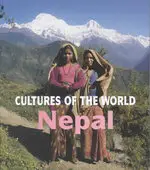 Every time I travel to a country I’ve never been before, I like to read up beforehand. Usually, I start with something easy, most of the times an album/country profile, and then I move on to more detailed books. As I’m planning to travel to Nepal in just a few months, and possibly on holidays to Goa in India, the first book that I found in my school library was Nepal by Jon Burbank (Marshal Cavendish, 2002). It is a Benchmark Book in the ‘Cultures of the World’ Series and, although, it is almost a decade old and thus some of the data might be outdated, the book still gives a good overview of this landlocked country in South Asia.
Every time I travel to a country I’ve never been before, I like to read up beforehand. Usually, I start with something easy, most of the times an album/country profile, and then I move on to more detailed books. As I’m planning to travel to Nepal in just a few months, and possibly on holidays to Goa in India, the first book that I found in my school library was Nepal by Jon Burbank (Marshal Cavendish, 2002). It is a Benchmark Book in the ‘Cultures of the World’ Series and, although, it is almost a decade old and thus some of the data might be outdated, the book still gives a good overview of this landlocked country in South Asia.
Formerly known as the Kingdom of Nepal (until the 2008 abolition of the monarchy), today, the official name of the country is Federal Democratic Republic of Nepal.
Most people know Nepal for its his mountain ranges, the Himalayan Mountains with the highest peak on Mount Everest. Himalaya is a Sanskrit word made up of hima, which means ‘snow,’ and alaya, which means ‘abode.’ (In Thai, the word for ‘snow’ is หิมะ, pronounced heema. This is not at all unusual, as Sanskrit, alongside Pali and Old Khmer, is one of the languages Thai massively borrowed from.)
Nepal is such an attractive destination as it houses eight of the ten tallest mountains in the world, including Mount Everest that soars at 8,850 m. Worldwide, there are only 14 mountain peaks over 8,000 m. The other six mountain peaks not located in Nepal are still in the region: Pakistan/China (K2, Gasherbrum I & II, Broad Peak), Pakistan (Nanga Parabat), and Tibet (Shisha Pangma).
Everest was confirmed as the tallest mountain in 1863, at a time when India was ruled by the British. (In 1999, the measurements were reconfirmed using modern technology by two American climbers and five Sherpa guides.) A survey done by the Indian Survey Office called it first ‘Peak 15,’ and then ‘Everest,’ after the name of a former head of the survey office. In their imperialistic arrogance, none of the surveyors bothered to ask the locals what they called the mountain! It actually had/has beautiful names: ‘Sagarmatha’ on the Nepali side and ‘Chomolungma’ on the Tibetan side. Both names translate as “mother of the earth.”
The Nepalis are so used to these high mountains that any large landform at an altitude between around 1,500 m and 3,600 m are just ‘hills.’ In any other country they would be called the obvious. (By comparison, the highest mountain in Thailand is Doi Inthanon at 2,565 m and the highest one in Romania is Moldoveanu at 2,544 m. Basically, “medium-sized hills” to Nepali standards!)
Because of the rough terrain and lack of powerful 4-wheel trucks, the locals measure distances not in miles or kilometers, but rather in hours or days it takes to walk to a destination. Imagine asking a villager of the Middle Hills, “Where’s your home?” and receiving the reply, “Oh, only a four hour-walk to the west.”
The capital city of Nepal is Kathmandu, located in the Kathmandu Valley and, according to the 2001 census, it has a population of a little over 670,000. There are seven World Heritage Sites within the valley! The city was founded by King Gunakamadeva in the 8th century. The name Kathmandu comes from that of a temple built in the 10th century in a city called Kasthamandap (now the name of the largest pagoda in Nepal).
Nepal is divided into 14 anchal, or zones. Each anchal is subdivided into jilla, or districts. There are 75 jilla, each with a legislative assembly. Each district is divided into villages. Each village has a village assembly. All Nepali citizens aged 18 or above can vote in elections for village, district, and national assemblies.
The most common animal seen in the Himalaya is the yak, a beast of burden that can live at high altitudes. As a matter of fact, if yaks travel below 2,000 m, they get reverse altitude sickness, which can be fatal to them. How many Everest climbers wish they had such a strong composition?
But, Nepal’s most intriguing ‘resident’ is the yeti, or the ‘Abominable Snowman,’ whose existence hasn’t actually been proved yet. The Sherpas, an ethnic group that lives high up in the Himalaya, call it the ‘yet-tch’ and believe there are two kinds: one that eats cattle and another that eats people. According to folktales, the yeti is taller than a person, with orange fur, and a pointed head. Some people claim that it belongs to a species of giant orangutans!
The red rhododendron, found in the Middle Hills at altitudes of around 2,700 m, is Nepal’s national flower. They bloom in spring, turning entire hillsides red.
(To be continued: History of Nepal)

thank you very much for this interesting read – I will be going to Nepal in September, so I am excited to read from your travel preparations!
@Moune: Stay tuned for more info on Nepal. I’m traveling to Nepal and Tibet this July! I’m really excited about it!
nepal sucks!
Why is that?